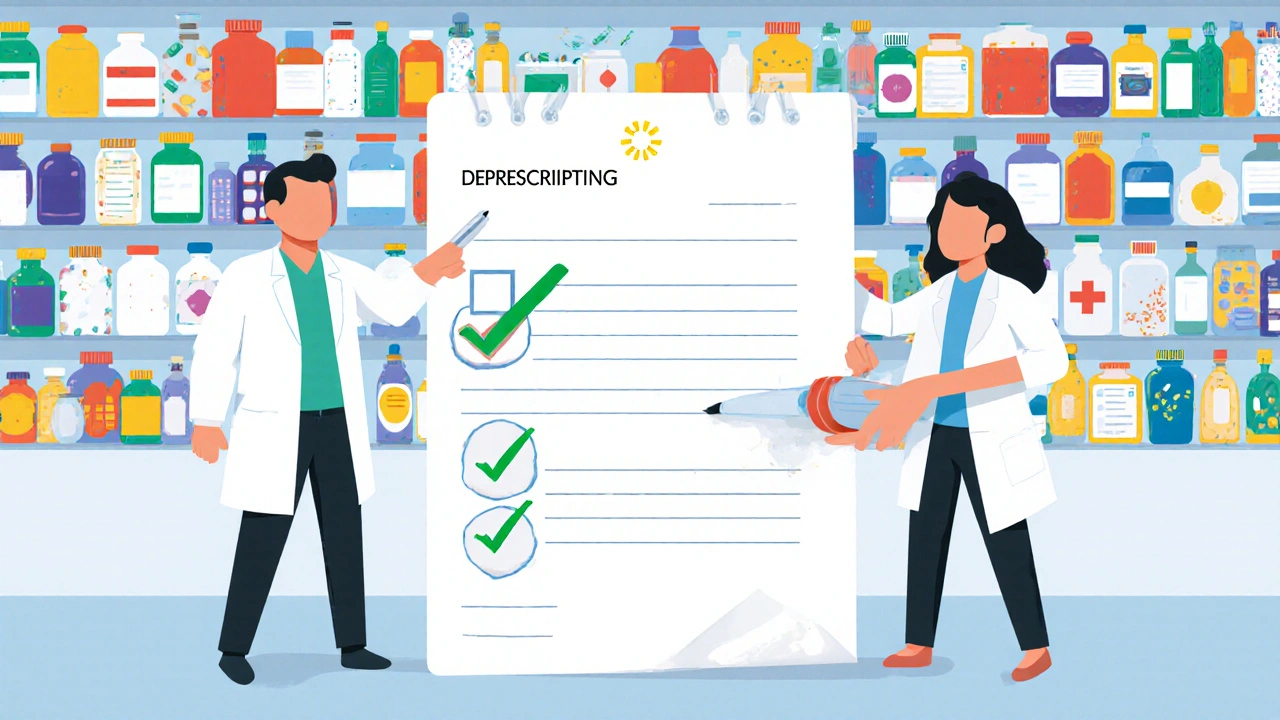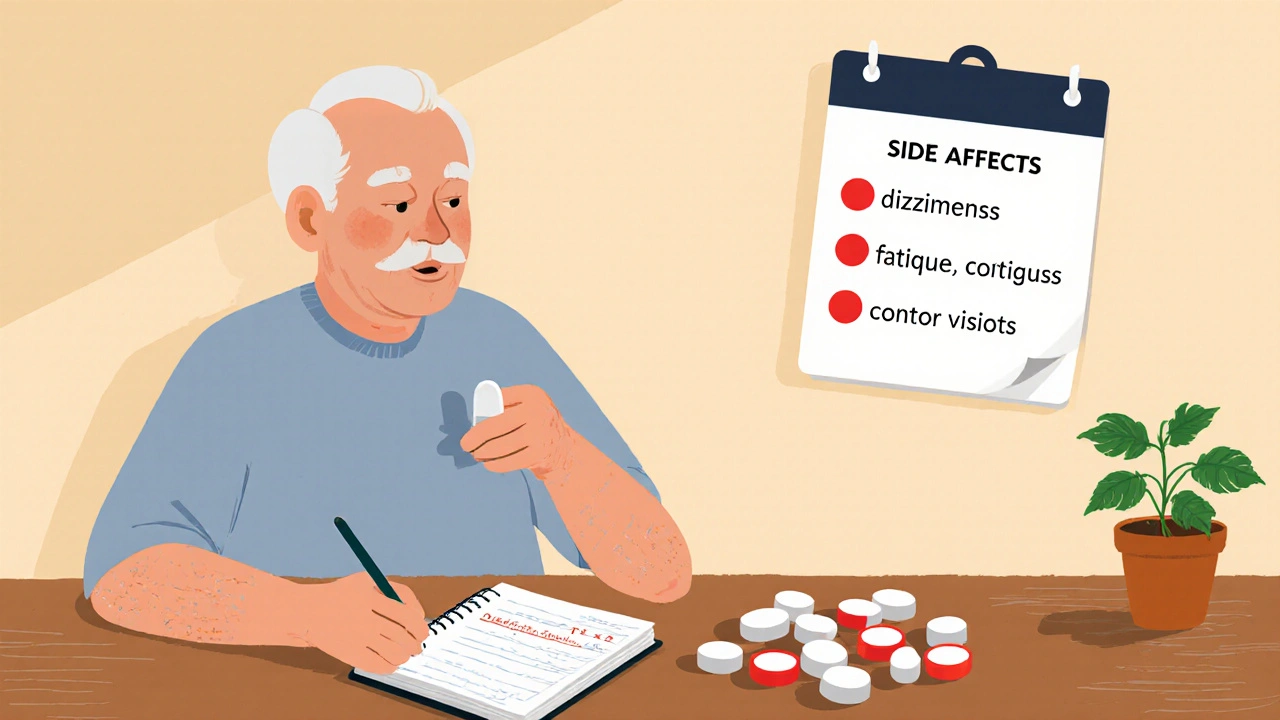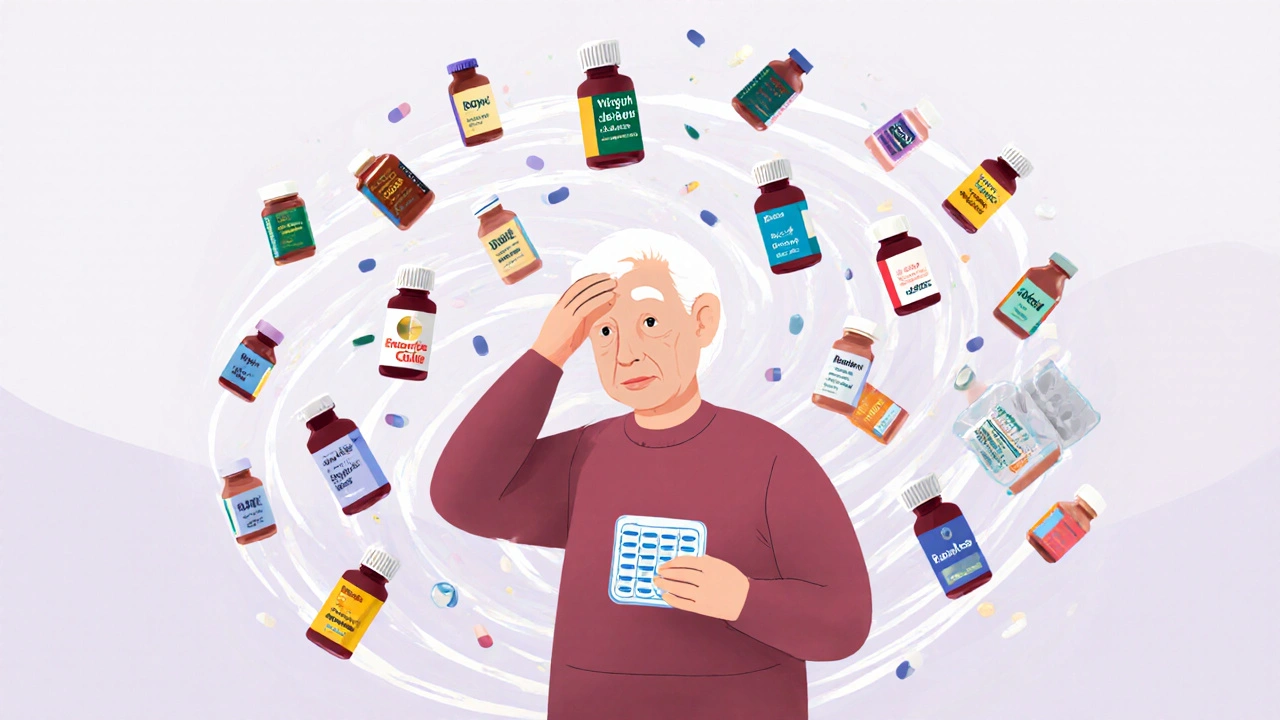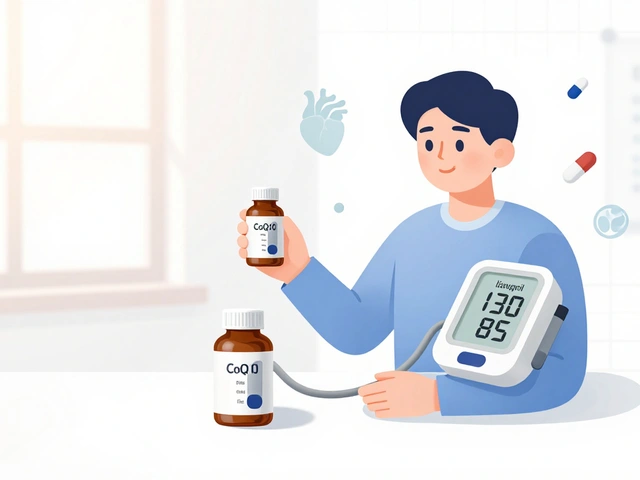Polypharmacy Risk Assessment Tool
How Many Medications Are You Taking?
The article states that more than 40% of adults over 65 take 5 or more medications daily. This tool assesses your risk level based on the number of medications and health conditions.
Your Risk Assessment
More than 40% of adults over 65 in the U.S. take five or more medications every day. That’s not just common-it’s dangerous. When you’re on that many pills, the risk of harmful side effects, hospital stays, falls, and even death goes up sharply. It’s not about taking too many pills for no reason. Sometimes, each one makes sense on its own. But together? They can turn your body into a battlefield.
What Exactly Is Polypharmacy?
Polypharmacy isn’t a diagnosis. It’s a term doctors use when someone is taking five or more medications regularly. That includes prescriptions, over-the-counter drugs like ibuprofen or antacids, and even vitamins or herbal supplements. It’s not always bad. For someone with heart disease, diabetes, and high blood pressure, five or more drugs might be exactly what they need to stay alive.
The problem isn’t the number. It’s the why and the how. When medications are added without reviewing what’s already being taken, things go wrong fast. A patient gets a new prescription for acid reflux, which causes dizziness. Then they’re prescribed a balance medication. Then a sleep aid. Then an antidepressant. Each one treats a symptom-but none of them fix the root cause. This is called a medication cascade, and it accounts for 30-40% of inappropriate prescribing in older adults.
Why More Medications Mean More Danger
Your body doesn’t handle drugs the same way when you’re 75 as it did at 45. Liver and kidney function slow down. Drug metabolism changes. What used to be a safe dose can now be toxic. Add in five or more drugs, and the chances of a bad interaction skyrocket.
Here’s what happens in real life:
- One in three people on five or more medications experience a side effect they believe is drug-related.
- People taking seven or more drugs are 42% more likely to have trouble walking or staying steady.
- Those on 10+ medications have a 28% higher risk of dying within a year compared to those on just one to four.
- Medication-related falls cause fractures in older adults-and polypharmacy makes those falls 1.5 to 2 times more likely.
And it’s not just physical. Many patients say they feel overwhelmed. One 72-year-old woman told her doctor she was taking 17 pills a day and couldn’t remember which ones she’d already taken. She felt like a pharmacy on legs. That’s not just inconvenient-it’s terrifying.
The Hidden Costs-Money, Time, and Mental Health
Medication costs add up fast. Someone taking five to nine drugs spends an average of $317 a month. For someone on 10 or more, that jumps to over $5,200 a year. Many people skip doses because they can’t afford it. One 68-year-old man said he had to choose between his heart medicine and food.
Time is another hidden cost. Managing a daily pill schedule with 10+ medications takes focus, organization, and memory. Many patients admit they just guess what they’ve taken. That’s how overdoses and missed doses happen.
And then there’s the mental toll. Anxiety, confusion, and social withdrawal are common. Nearly 30% of people on multiple medications say they’ve cut back on seeing friends or going out because they feel too tired or dizzy from their meds.

When Polypharmacy Actually Helps
Not all multiple medications are bad. For someone recovering from a heart attack, taking a beta blocker, statin, aspirin, and ACE inhibitor together reduces death risk by 50-60%. For someone with advanced heart failure and kidney disease, a combination of diuretics, SGLT2 inhibitors, and mineralocorticoid antagonists can improve survival and quality of life.
The difference? Appropriate polypharmacy is intentional. It’s based on clear guidelines, reviewed regularly, and each drug has a specific, evidence-based purpose. It’s not just adding pills because a specialist said so.
The real issue is when care is fragmented. A cardiologist prescribes one set of drugs. A neurologist adds another. A primary care doctor doesn’t know what the others ordered. No one steps back to look at the whole picture.
Deprescribing: The Solution No One Talks About
There’s a word doctors are starting to use more often: deprescribing. It means carefully stopping medications that aren’t helping-or are hurting. It’s not about cutting pills randomly. It’s a planned, gradual process that takes weeks or months.
Here’s how it works:
- Review every medication-prescription, OTC, supplement.
- Use tools like the Beers Criteria to flag potentially inappropriate drugs (like benzodiazepines, anticholinergics, or NSAIDs).
- Ask: Is this still needed? Is it causing side effects? Could it be replaced with lifestyle changes?
- Stop one drug at a time, watch for changes, and adjust.
One patient on 12 medications saw her dizziness and confusion disappear after just three were stopped. Another stopped a sleep aid and found he slept better without it. These aren’t rare cases-they’re common when deprescribing is done right.
But here’s the catch: only 35% of primary care doctors feel confident doing this. Most weren’t trained for it. Medical schools barely teach it. And without a full medication review, it’s easy to miss what’s unnecessary.

Who’s Responsible for Fixing This?
It’s not just the doctor’s job. It’s not just the patient’s job. It’s a team effort.
Pharmacists can help by doing medication reconciliations-comparing what’s prescribed to what’s actually being taken. They’ve been shown to reduce harmful events by 30%. Medicare now requires medication reviews for people on eight or more drugs. That’s progress.
Technology is helping too. Tools like MedWise, approved by the FDA in 2022, flag dangerous drug combinations before they’re prescribed. In one study, it cut high-risk interactions by 37%.
But the biggest change needs to come from how we think about medicine. We’ve been trained to believe more drugs = better care. That’s not true. Sometimes, less is more.
What You Can Do Today
If you or a loved one is on five or more medications, here’s what to do:
- Make a complete list of everything you take-name, dose, reason, how often.
- Bring it to your next doctor visit. Ask: “Which of these are still necessary?”
- Ask about deprescribing. Say: “I’m worried about side effects. Can we review what I’m on?”
- Don’t stop anything on your own. Work with your provider to taper safely.
- Track side effects: dizziness, confusion, fatigue, nausea, falls. Write them down.
It’s not about being anti-medication. It’s about being pro-safety. You deserve to feel better-not more confused, more tired, or more broke.
The Bigger Picture
Polypharmacy isn’t just a personal problem. It’s a system failure. In 2022, it cost the U.S. healthcare system $300 billion in avoidable expenses. It leads to 24% more hospital admissions and 32% more ER visits. By 2030, half of all adults over 65 will be on five or more drugs.
Without change, adverse drug events will rise 40% by 2035. But we have the tools to stop it: better training, better tech, better conversations.
The real question isn’t whether you need more pills. It’s whether you still need the ones you’re taking.
Is taking five or more medications always dangerous?
No, not always. For people with multiple chronic conditions like heart disease, diabetes, and kidney problems, five or more medications may be necessary and life-saving. The danger comes when medications are added without reviewing their purpose, when they interact, or when they’re no longer needed. The key is whether the benefits outweigh the risks-and whether each drug is still serving its original goal.
Can I stop my medications on my own if I feel side effects?
Never stop a medication without talking to your doctor first. Some drugs, like blood pressure pills or antidepressants, can cause serious withdrawal symptoms if stopped suddenly. Side effects are a signal that something needs to change-but the change should be planned, not rushed. Work with your provider to safely adjust your regimen.
What are the most common dangerous drug combinations in polypharmacy?
The most dangerous combinations often involve drugs that affect the central nervous system. For example: benzodiazepines (like Xanax) plus opioids or sleep aids can cause dangerous breathing problems. Anticholinergics (used for overactive bladder or allergies) combined with other drugs that cause drowsiness increase fall risk. NSAIDs like ibuprofen with blood thinners raise bleeding risk. These are the top offenders flagged by the Beers Criteria and FDA safety alerts.
How often should I get my medications reviewed?
If you’re taking five or more medications, you should have a full review at least once a year-and more often if your health changes. The American Geriatrics Society recommends this for all older adults on multiple drugs. After any hospital stay, surgery, or major illness, a medication review is essential. Don’t wait for your doctor to bring it up-ask for it.
Are over-the-counter drugs and supplements really part of the problem?
Absolutely. Many people don’t think of ibuprofen, antacids, melatonin, or herbal supplements as "medications," but they can interact with prescriptions and cause side effects. For example, St. John’s Wort can reduce the effectiveness of blood thinners and antidepressants. Calcium supplements can interfere with thyroid meds. Always include everything you take-no matter how "natural" it seems-in your medication list.
What’s the difference between polypharmacy and medication non-adherence?
Polypharmacy means taking many medications. Non-adherence means not taking them as prescribed-skipping doses, taking too much, or stopping early. These often go hand-in-hand. When a regimen is too complex or expensive, people stop taking pills. In fact, patients on 10+ medications are 3.2 times more likely to miss doses than those on just one to four. The solution isn’t just adding more drugs-it’s simplifying the ones you have.




Rishabh Jaiswal
October 27, 2025 AT 22:43lol i took 17 pills yesterday and my dog looked at me like i was a walking pharmacy lol
May Zone skelah
October 28, 2025 AT 07:22Let me tell you, darling, I read this piece with the kind of intellectual rigor one reserves for Proust or the collected works of Dr. Atul Gawande. The systemic failure of geriatric pharmacotherapy is not merely a clinical issue-it’s a metaphysical tragedy of modern medicine’s hubris. We’ve turned human beings into pharmacological punch cards, and the cost? Not just dollars, but the very essence of dignity. I weep for the 72-year-old woman who feels like a ‘pharmacy on legs’-because that’s what we’ve become: walking polypharmacy exhibits in a museum of unintended consequences. And don’t even get me started on the Beers Criteria. It’s like the DSM-5 for pills-arbitrary, outdated, and shamefully under-enforced by a system that profits from dependency.
Someone needs to write a memoir. ‘I Took 12 Pills Today and All I Got Was This Lousy Confusion.’ I’d buy it in hardcover.
Dale Yu
October 28, 2025 AT 11:11you people are so naive. doctors are in the pocket of big pharma. they dont care if you die as long as you keep buying pills. they dont want you to get better they want you to stay sick. the whole system is rigged. i know a guy who stopped all his meds and his diabetes vanished. they dont tell you that. theyll never tell you that. its all about the money. your doctor is lying to you. every single one.
Kshitij Nim
October 29, 2025 AT 19:37Hey, I get it-this stuff is overwhelming. I’ve helped my mom cut down from 14 pills to 7. It wasn’t easy, but we worked with her pharmacist and tracked every side effect. She sleeps better now, doesn’t stumble walking to the bathroom, and actually remembers birthdays again. Deprescribing isn’t about quitting meds-it’s about reclaiming your life. Start with one. Talk to your pharmacist. Write it down. You got this.
Scott Horvath
October 31, 2025 AT 02:44so i had this cousin who was on 11 meds and one day she just stopped writing stuff down and started calling her cat ‘doctor’ and i was like… maybe the meds are the problem
she cut back to 4 and now she’s baking pies and arguing with the neighbors about garden gnomes. life is weird but sometimes less is more
Armando Rodriguez
November 1, 2025 AT 19:53This is one of the most comprehensive and urgently needed discussions on medication safety I’ve encountered in recent years. The data presented is not only statistically robust but also deeply human. The concept of ‘appropriate polypharmacy’ versus ‘unintentional polypharmacy’ is critical for clinical practice. I urge all healthcare professionals to internalize the principles of deprescribing and integrate them into routine care. The role of pharmacists, technology, and patient advocacy cannot be overstated. This is not just medicine-it’s moral responsibility.
matt tricarico
November 1, 2025 AT 21:43Of course the system is broken. You think this is about health? No. It’s about control. The FDA, AMA, and Big Pharma have created a religion of pills. They don’t want you to heal-they want you to depend. The ‘medication cascade’? That’s not an accident. It’s designed. They profit from chronicity. They profit from confusion. They profit from your fear. And now they’ve got you believing that ‘reviewing’ your meds is the solution. It’s not. The solution is to stop trusting them. Completely.
Patrick Ezebube
November 3, 2025 AT 08:54you know what’s really happening? the government is putting fluoride and lithium in the water to make us docile. then they sell us pills to ‘fix’ the side effects they created. they want us confused. they want us tired. they want us dependent. the ‘beers criteria’? a distraction. the real villain is the CIA’s MKUltra legacy still running through your pharmacy. check your meds. if it’s got a number and a logo? it’s poison. they’ve been doing this since the 60s. you think this is about aging? no. it’s about population control.
jerry woo
November 4, 2025 AT 17:04polypharmacy is the modern-day equivalent of throwing spaghetti at the wall and seeing what sticks. doctors don’t diagnose-they shotgun prescriptions like it’s a damn buffet. and then they act shocked when you’re dizzy, constipated, and crying over a commercial for dog food. the real tragedy? most of these pills were prescribed for symptoms that would’ve vanished if someone had asked, ‘have you tried walking more?’ or ‘are you lonely?’ or ‘did you eat anything besides frozen pizza this week?’ we’ve outsourced healing to chemical cocktails because it’s faster, cheaper, and way less awkward than listening.
and don’t even get me started on ‘natural supplements.’ your ‘herbal’ melatonin? probably laced with benzos. your ‘immune booster’? probably just sugar and a prayer. the whole system is a glitter-covered dumpster fire.
Jillian Fisher
November 4, 2025 AT 22:59I’ve been taking 6 meds for years and never thought to ask if I still needed them. I just assumed it was normal to feel foggy. I made a list and brought it to my PCP last week. We cut two-my sleep aid and an old anxiety med. I didn’t realize how much my brain had been buzzing until it stopped. I slept 8 hours straight last night. Who knew?
Suzanne Lucas
November 5, 2025 AT 01:32OMG I JUST REALIZED I’VE BEEN TAKING MY GRANDMA’S BLOOD PRESSURE PILLS BECAUSE THEY LOOKED LIKE MINE AND NOW I’M SCARED I’M GOING TO DIE AND MY CAT IS JUDGING ME